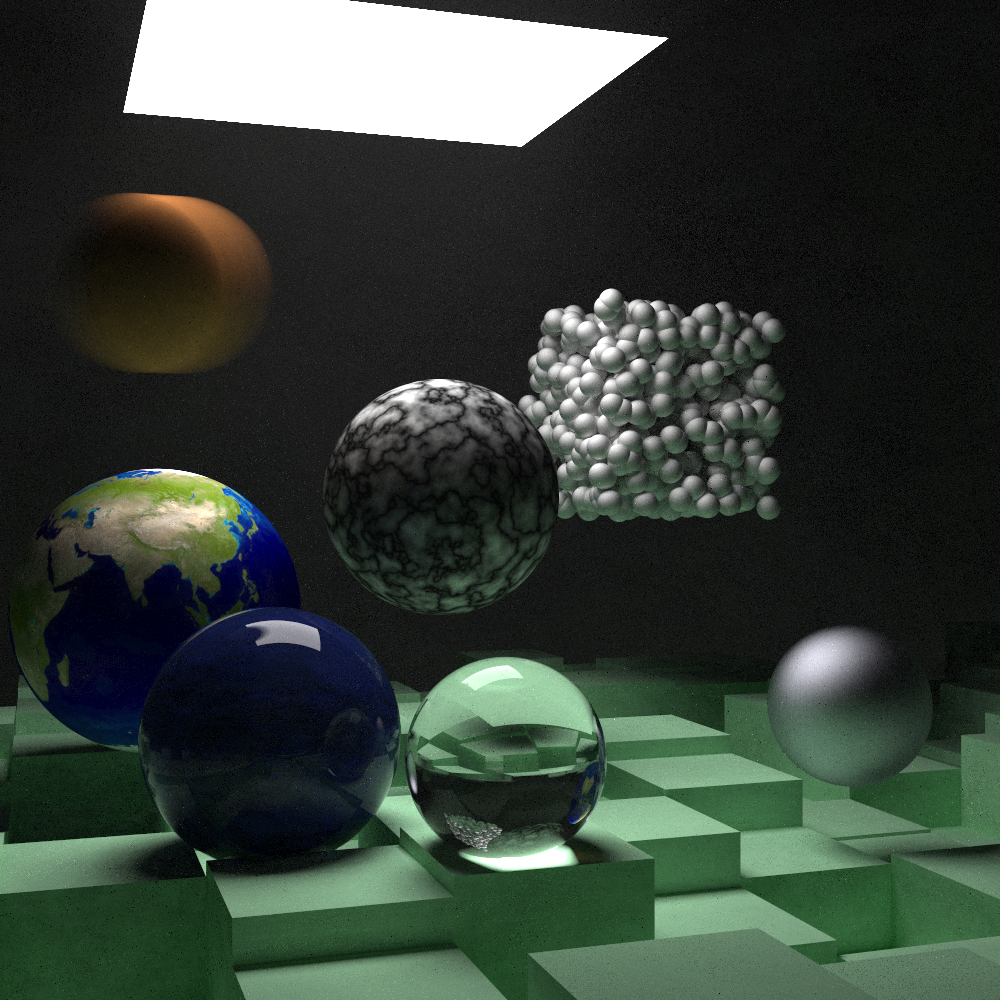This is a port of Ray Tracing: the Next Week to the purely functional data-parallel language Futhark, which can generate efficient GPU code. See also the Futhark implementation of Ray Tracing in One Weekend.
The scene below took about 90 seconds to render on an AMD RX 7900 XT GPU, and is 1000x1000 pixels, with 5000 samples per pixel, and a maximum of 50 reflections per ray.
This ray tracer was substantially more difficult to implement than the weekend version it is based on, and the problems mentioned there still apply. I encountered the following new problems.
Peter Shirley's C++ implementation uses a simple and elegant recursive divide-and-conquer technique for constructing the BVH. Futhark does not support recursion, so I really dreaded implementing this. Fortunately, Tero Karras has written a wonderful paper titled Maximizing Parallelism in the Construction of BVHs, Octrees, and k-d Trees which presents an elegant data-parallel algorithm for constructing radix trees. My Futhark implementation is quite simple and runs fast, and it is straightforward to build the BVH on top of that. In the end, BVH construction ends up taking less than 0.02% of the total runtime, yet makes the run time O(log(n)) rather than O(n) in the number of objects.
One significant difference is that my implementation constructs the BVH for the entire scene, whereas the C++ implementation permits a kind of manual decomposition as well. I think the latter may be better for irregular scenes, like the demo image above, where the BVH is only really useful for the floor and the cube made of spheres.
In the C++ implementation, certain objects are expressed recursively. For example, the "tiled" texture, where the even/odd tiles are their own texture objects. In my implementation, the even/odd tiles must simply be flat colours. Also, "mediums" (fog) is hacked in as a kind of special flag on objects. The whole idea of formulating fog as a surface seems to be a hack in the first place, so I don't feel too bad about it. One resulting limitation is that fog only works well in the form of spheres.
The biggest limitation is that I do not support aggregate objects. In the C++ implementation, operations such as translation and rotation can be applied to an entire collection of objects. In my Futhark implementation, all objects are primitives (spheres or rectangles), and transformations can only be applied to each object in isolation. I am pretty sure that this means rotation does not work correctly (the sphere-cube in the image above looks incorrectly positioned compared to reference images). I think this can be fixed by someone who has a better grasp of 3D geometry than I have.
The C++ implementation permits objects to be textured with an image
loaded from disk, like the Earth sphere in the image above. Since
Futhark does not permit file IO, I support this via a hack. I permit
a single image texture (although it can be used on different
objects) that is piped in as input when the program is run. The
example texture is stored in the repository in the file
earthmap.data using the Futhark binary data
format
(essentially the raw bytes prefixed with size information). In
principle this could be extended to multiple images using some kind of
packing technique.
An otherwise very good Rust implementation does not implement image textures at all, so I feel like I'm in good company!
The C++ implementation defines three classes of rectangles, one for
each pair of axes (x/y, x/z, y/z). I did not want to do this, because
each of them is almost identical to the other, and branching too much
can be harmful for SIMD
performance. Instead, I
use a single rect type with a tag indicating to which axes it is
aligned.
I found that GPU performance was severely limited because the
generated code was using too many scalars. This limits the number of
threads that can run concurrently on the GPU (or alternatively,
requires expensive spills to global memory). The main culprit was
iterating the BVH looking for the best hit, where I kept a full hit
record as a loop variant value (including material, a large type).
This is because Futhark does not support references or pointers, but
is fully pass-by-value. I changed the BVH iteration to only keep
track of the index of the closest object found so far, and re-run
the hit calculation with the final object at the end, which made the
run time drop by a factor of two.
You will need Futhark 0.25.1 or newer to run this code. You will also need data2png.py, which turns Futhark values into PNG images. Once these are available, run:
$ futhark pkg sync
$ futhark opencl raytracer.fut
$ (echo 1000 1000 5000; cat earthmap.data) | ./raytracer -b | python data2png.py /dev/stdin scene.png
